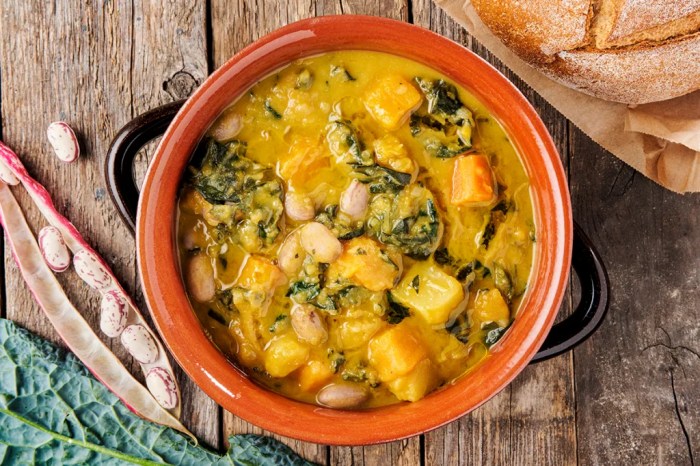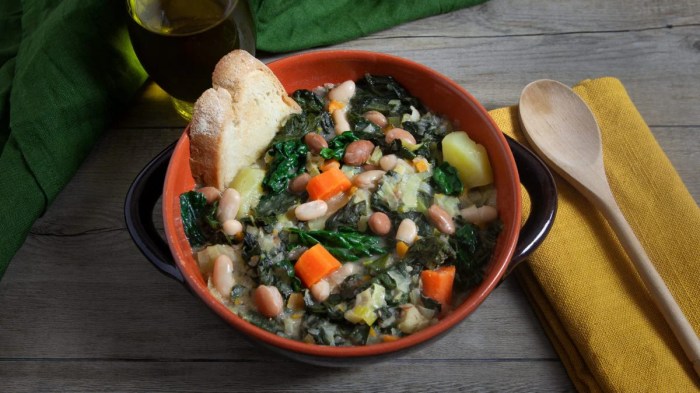Zuppa Frantoiana, a Tuscan culinary treasure, invites us on a tantalizing journey through the heart of Italy’s olive-growing regions. With its rich history, vibrant flavors, and regional variations, this delectable soup embodies the essence of Italian cuisine.
From its humble origins to its modern interpretations, Zuppa Frantoiana has captivated taste buds for centuries. Join us as we delve into the secrets of this beloved dish, exploring its ingredients, cooking techniques, and the culinary traditions that have shaped its unique character.
Zuppa Frantoiana History and Origin
Zuppa Frantoiana, a traditional Italian soup, traces its culinary roots to the region of Tuscany. Originating in the 16th century, this hearty and flavorful dish has become a cherished part of Tuscan cuisine and a testament to the region’s rich culinary heritage.
The name “Frantoiana” derives from the Italian word “frantoio,” meaning “olive mill.” Historically, this soup was prepared during the olive harvest season, using fresh, locally produced olive oil. The abundance of olives in Tuscany made this ingredient readily available and gave the soup its distinctive flavor profile.
Regional Variations
Over time, Zuppa Frantoiana has evolved and adapted to different regions within Tuscany, resulting in variations in its preparation and ingredients. In the northern part of Tuscany, the soup is typically made with a broth based on chicken or beef, while in the southern part, a vegetable broth is more common.
Additionally, the choice of vegetables used in the soup varies depending on the region, with some variations including cabbage, carrots, celery, and potatoes.
Evolution of the Recipe
The recipe for Zuppa Frantoiana has undergone subtle changes over the centuries, reflecting the influence of changing tastes and culinary techniques. While the core ingredients of bread, vegetables, and olive oil remain constant, the use of spices and herbs has evolved.
In the past, the soup was often seasoned with simple herbs like rosemary and thyme, but today, a wider variety of spices, such as garlic, pepper, and chili flakes, are commonly added to enhance its flavor.
Ingredients and Variations
Zuppa Frantoiana, a traditional Tuscan soup, is a culinary masterpiece that showcases the flavors of the region. Its base is a rich and flavorful broth made from seasonal vegetables, herbs, and extra-virgin olive oil.
Traditional Ingredients
- Fresh vegetables:Typically includes carrots, celery, onions, and tomatoes.
- Herbs:Rosemary, thyme, and sage add an aromatic touch.
- Extra-virgin olive oil:The star ingredient, providing a fruity and robust flavor.
- Bread:Stale bread, toasted or grilled, is added for texture and to soak up the flavorful broth.
- Beans:Cannellini beans or other white beans add protein and creaminess.
- Garlic:A key flavor enhancer, used both fresh and roasted.
- Salt and pepper:To taste.
Variations and Substitutions
While the traditional ingredients remain the backbone of Zuppa Frantoiana, variations exist across different regions of Tuscany.
- Vegetable variations:Some variations may include additional vegetables such as zucchini, bell peppers, or spinach.
- Beans and lentils:Other types of beans or lentils can be substituted for cannellini beans.
- Broth variations:Some recipes use vegetable broth or a combination of vegetable and chicken broth.
- Bread alternatives:Croutons or even pasta can be used instead of toasted bread.
- Modern interpretations:Contemporary chefs may add unique ingredients such as roasted fennel, toasted nuts, or even seafood to create modern variations.
Cooking Techniques and Methods
Creating Zuppa Frantoiana involves a harmonious blend of culinary techniques and methods that elevate its flavors and textures. The process begins with a fragrant soffritto, where aromatic vegetables are gently sautéed in olive oil to release their essence. This flavorful base sets the stage for the addition of plump chickpeas, which are simmered in a rich vegetable broth until tender.
Vegetable Sauté (Soffritto), Zuppa frantoiana
- Finely chop onions, carrots, and celery into small, uniform pieces.
- Heat olive oil in a large pot or Dutch oven over medium heat.
- Add the chopped vegetables and cook, stirring occasionally, until softened and translucent.
- Season with salt and pepper to taste.
Chickpea Simmering
- Rinse and sort dried chickpeas to remove any debris.
- Add the chickpeas to the pot with the sautéed vegetables.
- Pour in vegetable broth or water to cover the chickpeas by about 2 inches.
- Bring to a boil, then reduce heat and simmer for 1-2 hours, or until the chickpeas are tender but still hold their shape.
- Season with additional salt and pepper as needed.
Achieving Desired Consistency and Presentation
The desired consistency of Zuppa Frantoiana can be adjusted by varying the amount of liquid used. For a thicker soup, use less broth or water. For a thinner soup, add more liquid. Once the chickpeas are tender, use an immersion blender or a regular blender to purée a portion of the soup to create a smooth, creamy texture.
Garnish with fresh herbs, such as parsley or basil, and a drizzle of extra virgin olive oil for an elegant presentation.
Regional Adaptations and Influences
Zuppa Frantoiana, like many Italian dishes, exhibits regional variations that reflect the unique culinary traditions and local ingredients of different parts of Italy. These variations showcase the creativity and adaptability of Italian cuisine, resulting in a diverse array of flavors and presentations.
In Tuscany, where Zuppa Frantoiana originated, the soup is typically made with a rich broth flavored with vegetables, herbs, and cured meats. In Umbria, the soup is often thickened with a roux made from flour and butter, giving it a creamy texture.
In Lazio, the soup may include tomatoes or tomato paste, adding a vibrant color and a touch of acidity.
Ligurian Adaptation
In Liguria, a coastal region in northwestern Italy, Zuppa Frantoiana takes on a distinct character. The soup base is made with a combination of fish stock and vegetable broth, resulting in a light and flavorful liquid. Local seafood, such as mussels, clams, and prawns, are added to the soup, giving it a rich and briny flavor.
The soup is often garnished with a drizzle of Ligurian olive oil, renowned for its delicate and fruity notes.
Puglian Adaptation
In Puglia, a region in southeastern Italy known for its olive oil production, Zuppa Frantoiana showcases the region’s culinary heritage. The soup is made with a base of vegetable broth and extra virgin olive oil, imparting a robust and herbaceous flavor.
Local vegetables, such as tomatoes, onions, and peppers, are added to the soup, giving it a vibrant color and a touch of sweetness. The soup is often garnished with toasted bread cubes and a sprinkle of grated Parmesan cheese.
Zuppa frantoiana, a rustic Italian bread soup, has a rich history. If you’re looking for a healthier snack to pair with your soup, you might consider how to make quest protein chips . With just a few ingredients, you can make crispy, protein-packed chips that will satisfy your cravings.
Back to zuppa frantoiana, the addition of stale bread to the soup gives it a hearty texture and depth of flavor.
Serving and Accompaniments

Traditionally, Zuppa Frantoiana is served piping hot in individual bowls or terracotta dishes. It is customary to drizzle a generous amount of freshly pressed extra virgin olive oil over the soup before serving, enhancing its flavor and richness.
To complement the hearty flavors of Zuppa Frantoiana, consider serving it with crusty bread or toasted croutons. These accompaniments provide a perfect canvas for soaking up the flavorful broth. Additionally, a side of grated Parmesan cheese can be offered to allow diners to customize the soup’s savoriness to their liking.
Wine and Beverage Pairing
When it comes to wine pairing, Zuppa Frantoiana pairs exceptionally well with light-bodied white wines such as Pinot Grigio or Sauvignon Blanc. These wines complement the delicate flavors of the soup without overpowering them. Alternatively, a glass of crisp rosé or a refreshing beer can also be enjoyed alongside this Tuscan delicacy.
Nutritional Value and Health Benefits: Zuppa Frantoiana

Zuppa Frantoiana is a nutrient-rich dish packed with vitamins, minerals, and antioxidants.
The main ingredients, such as tomatoes, garlic, and basil, are known for their health-promoting properties. Tomatoes are a rich source of lycopene, an antioxidant that has been linked to reduced risk of certain types of cancer and heart disease. Garlic is a potent antimicrobial and antiviral agent, while basil is rich in antioxidants and anti-inflammatory compounds.
Role in a Balanced Diet
Zuppa Frantoiana can be a valuable addition to a balanced diet. It is a low-calorie, high-nutrient dish that can help meet daily requirements for vitamins, minerals, and antioxidants.
The soup is also a good source of fiber, which can help regulate digestion and promote satiety. Additionally, the healthy fats in olive oil can contribute to heart health and reduce inflammation.
Conclusive Thoughts
Zuppa Frantoiana stands as a testament to the enduring power of culinary traditions, a dish that has evolved over time while remaining true to its roots. Whether enjoyed as a comforting meal or a celebration of Italy’s olive harvest, this soup continues to delight and inspire.








